Would Counter Surveillance Have Stopped the Charlie Hebdo Assault?
In the aftermath of the terrorist incident that left civilians and public servants reeling in France, much has been written and opined as these tragic events are reviewed. Unfortunately, this manner of violence gains worldwide attention. As the timeline and actions are broken down and dissected by the masses in an effort to learn what could have been done to prevent this tragedy, the media has focused predominantly on the preventative measures in place and why these terrorists were not being watched. My perspective to understanding what happened in France is geared more toward the security discipline of surveillance and specifically counter surveillance in order to be more aware of similar situations that might present themselves here.
The French authorities are currently reviewing their multi-jurisdictional intelligence collection and information sharing capabilities. One of their goals is to determine where on their surveillance radar were the Kouachi brothers, both of whom had been arrested on multiple occasions for involvement in terrorist activities. The French authorities had clearly identified one of the brothers as a “person of interest,” but this threat apparently dissipated and they decided to discontinue tracking these subjects. One reason could be budgetary, since keeping even one person under continuous surveillance requires a significant financial investment in resources. France reportedly has over 1,000 persons under surveillance who have recently traveled to Iraq and Syria. Trying to keep these numbers under surveillance can overwhelm capacity, not just monetarily, but also in human capital.
While I agree that intelligence gathering and assessing are critical preventative and investigative tools, we have other means at our disposal to combat mass violence. Surveillance is another piece to the counter-terrorism puzzle and comes in many different shapes and sizes in the modern world. From satellites in war zones tracking and locating Al Qaeda leaders to pinhole cameras watching, recording, and catching corrupt politicians, the advancement of technology has provided a variety of means to surreptitiously watch, listen, and follow a target.
Even with all of these techno gadgets, nothing compares to traditional surveillance, whether it is achieved through driving, walking, or stationary means. Because of our ability to think, reason, and conclude, the human element simply cannot be dismissed. And since technology often fails, a multi-layered plan must be in place to achieve the best results. Some have speculated that the Charlie Hebdo offices had been under surveillance leading up to the attack because the terrorists entered the building at the same time as the weekly staff meeting. It has been well documented that they initially went to the wrong building, which weakens this conjecture; however, it was either coincidental or they knew this meeting was taking place. Whatever the situation, the result remains the same—eight journalists were killed. If the assault had happened on any other day or time, it is unlikely that the entire staff would have been on the premises.
I believe that this was well-planned, rehearsed, and thought out, with contingencies in place. If you can accept this possibility, then I am able to present what I believe may have been done to mitigate this threat and possibly thwart this act of violence. The principal goals of counter surveillance are to conduct sporadic observation of the areas of interest and to identify any unusual behavior or persons showing undue interest for a site, person(s), or function. Counter surveillance is especially important because it is one of the few security measures that allows for threats to be dealt with before they can develop into full-scale attacks.
One common denominator of all the different potential threats—whether from lone wolves, militant groups, common criminals, or the mentally disturbed—is that those planning an operation monitor their target in advance. Regardless of the length of time surveillance is performed, the criminal or terrorist conducting it is exposed, and therefore vulnerable to detection. Because of this, counter surveillance—the process of detecting and mitigating hostile surveillance—is an important, though often overlooked, element of counterterrorism and security operations.
Law enforcement departments and security organizations could consider developing this methodology to enhance security measures with respect to detecting and deterring the types of threats associated with either an organized group or lone individual. Counter surveillance could be used at a threatened site, such as the Charlie Hebdo offices, or when an organized protest is staged at public events. Security guards and police officers can be trained in counter surveillance techniques to bolster the protective tactics used to protect these people, places, and properties. Counter surveillance is just another tool in the tool box to consider in our war against the worldwide threat of terrorism.

